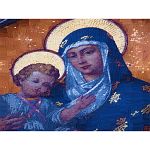
Walk to the lower part of
Kalamegdan Fortress passing the
Nebojsa Tower which used to be a prison during the Turkish occupation and which today is a museum dedicated to the Greek revolutionary Rigas Feraio, strangled by the Turks here and thrown into the Danube. Not far from the tower is
St Petka’s Church, well known for its spring which according to locals has healing powers. The church has lovely mosaics and also relics (bones) of the saint herself which are displayed every Friday.
A few yards away is
St Ruzica Church, the oldest Orthodox Church in Belgrade, which was badly damaged during WWI and rebuilt in 1925 when two statues of soldiers were added at the entrance.
On the famous Knez Mihailova Street is
Bajrakli Mosque, built around 1575 by the Ottoman Sultan, Suleiman the Magnificent. During the Austrian occupation (1717 -1739) the mosque was converted to a Catholic Church only to be changed back again in 1741 during the Turkish invasion. Today it is the only active mosque in Belgrade.
Not far from the mosque is
Belgrade’s Synagogue, opened in 1926. This synagogue is the only active synagogue in Serbia and its rituals are held by Serfadi Jews who came to Serbia during the 1490s from Spain and Portugal.
Crossing Knez Mihailova Street see the most prominent Orthodox Christian place of worship,
the Saborna Crkva, also known as the
Cathedral Church of St. Michael the Archangel. The cathedral was built in 1840 by Prince Miloš Obrenović, one of Serbia’s

early kings. The church was built in the neo-classical style with late baroque elements, and the interior is richly decorated with a carved golden iconostasis. At the entrance in a small garden are two graves, one of them of the Serbian linguist, Vuk Karadzic, who is best known for his book on Serbian spelling,
Write as you speak and Read as it is written. The second grave belongs to Dositej Obradovic, the Serbian author, philosopher and linguist
who tirelessly advocated ideas of European Enlightenment and Rationalism.
Opposite the Cathedral Church there is
the Serbian Orthodox Patriarchate which was built in 1935. On the main façade an impressive portico has low columns and an arched portal above which is a sculpted coat of arms of the Patriarchate of Serbia. On the top of this facade, in a niche, is a mosaic representing St. John the Baptist.
Closer to Tasmajdan Park there is
St Mark’s Church built from 1931 to 1940 in the Serbo- Byzantine style. At the south end of this church is a sarcophagus with the remains of the Serbian Emperor Stefan Dusan, and at the north end is a crypt of white marble containing the body of Patriarch German Doric. St Mark’s has a highly valuable collection of 18th and 19th century Serbian icons, and next door is a small
Russian Orthodox church.In the centre of Belgrade there is a new addition to the city’s religious architecture,
the Cathedral of Saint Sava which, once

finished, will be the largest active Orthodox Church in the world. The church is dedicated to Saint Sava, the founder of the Serbian Orthodox Church and it is located where Saint Sava is thought to have been burned in 1595 by the Ottoman Empire’s Sinan Pasha. Work on the cathedral started in 1935 only to be stopped during WWII. In 1985 the Patriarch reapplied for permission to continue building only to be refused 88 times, and permission to finish the building was finally granted in 1984.
The topmost point of the cathedral is some 134 m (439.6 ft) above sea level and is visible from everywhere in the city. The interior of the church is not yet finished but standing inside even now is impressive and awe-inspiring.
Please email
tara@ReadyClickAndGo.com for further information.










